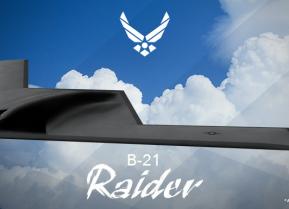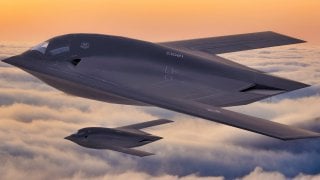China's H-20 Bomber Is a Real Threat to the U.S. Military
The Xian H-20 stealth bomber is designed as the last piece of the Chinese military’s nuclear triad. The People’s Liberation Army Rocket Force and the People’s Liberation Army Navy both have nuclear capability (ballistic missiles that can be launched from the ground and submarines, respectively).
The Xian H-20 stealth bomber is one of the most ambitious projects of a Chinese military that is seeking to become the regional power in the Indo-Pacific.
Still under development, the Xian H-20 stealth bomber will give the Chinese military an air-delivered nuclear capability in addition to a powerful conventional bomber.
H-20: A Deep Penetration Bomber
All the available evidence—which, to be sure, is limited—suggests that the Chinese military has opted for stealth and deep penetration capabilities rather than speed and agility.
Put simply, the Chinese military seems to be preferring an aircraft that will be hard to detect and will have the necessary systems that would allow it to penetrate deep inside the anti-aircraft umbrella of an adversary over an aircraft that will be able to outrun or outmaneuver enemy fighter jets or anti-aircraft missiles.
The Xian H-20 stealth bomber is no stranger to the U.S. military and intelligence community.
In the past, the Defense Intelligence Agency (DIA) has assessed that the Chinese military is designing the Xian H-20 stealth bomber to have an operational range of anywhere between 4,000 to 5,000 miles.
In addition, the Defense Intelligence Agency has assessed that the new Chinese stealth bomber will be outfitted with an Active Electronically Scanned Array (AESA) radar in order to better identify incoming threats, such as anti-aircraft missiles or enemy fighter jets.
As far as a fully operational capability goes, the Chinese military aims to have something by the end of the decade, a timeline that roughly aligns with the one the U.S. Air Force has for its future stealth bomber, the secretive B-21 Raider.
The Final Piece of a Nuclear Triad
The Xian H-20 stealth bomber is designed as the last piece of the Chinese military’s nuclear triad. The People’s Liberation Army Rocket Force and the People’s Liberation Army Navy both have a nuclear capability (ballistic missiles that can be launched from the ground and submarines respectively).
But Beijing has been lacking an air-delivered nuclear munition. And the Xian H-20 stealth bomber is designed to fill that capability gap and give Beijing a true nuclear triad—the ability to launch nuclear weapons from the land, air, and sea, thus giving a country full nuclear deterrence.
“China maintains nuclear-capable delivery systems in its Rocket Force and Navy. As of 2017, the Air Force had been reassigned a nuclear mission, probably with a developmental strategic bomber,” the Defense Intelligence Agency had assessed in a report back in 2019 about the Xian H-20 stealth bomber.
“The bomber’s deployment would provide China with its first credible nuclear triad of delivery systems dispersed across land, sea, and air—a posture considered since the Cold War to improve survivability and strategic deterrence,” the Defense Intelligence Agency report had added.
About the Author and Their Expertise
Stavros Atlamazoglou is a seasoned defense journalist specializing in special operations and a Hellenic Army veteran (national service with the 575th Marine Battalion and Army HQ). He holds a BA from the Johns Hopkins University and an MA from the Johns Hopkins’ School of Advanced International Studies (SAIS). His work has been featured in Business Insider, Sandboxx, and SOFREP.
Note: Shutterstock image is of a B-21 Raider Stealth Bomber, artist rendering.


